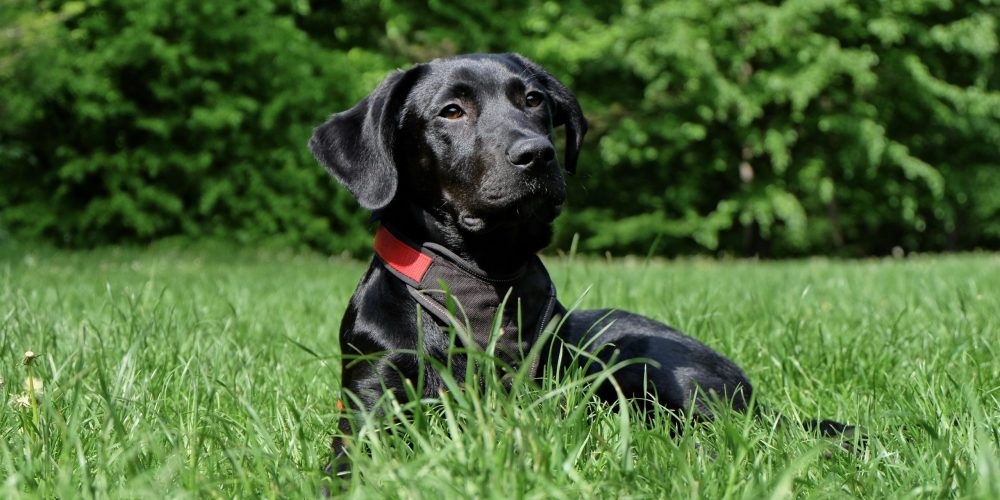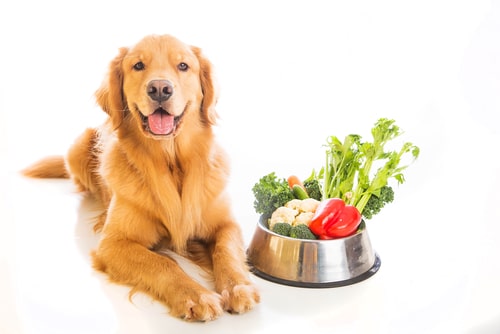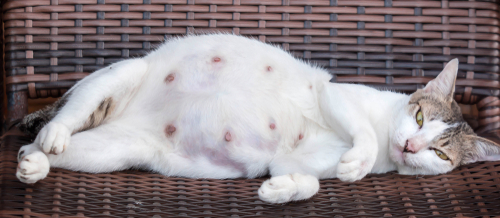Labradors have been our workmates and loyal companions for 500 years. They originally come from Newfoundland in Canada. But they got the name ‘Labradors’ when they came to the UK in the 1800’s. To many of us, they are the ultimate ‘Man’s Best Friend’.
The Labrador/ Labrador Retriever:
- Average weight: 25–35 kg, medium to large breed
- Colours: Black, Chocolate and Yellow, including variants like Fox Red
- Average life expectancy: 10-12+ years (slightly shorter for Chocolate Labradors)
- Exercise requirements: minimum 1.5 to 2 hours per day.
- Character: Loyal, dependable, intelligent, easy to train, courageous, even-tempered and gentle.
Labradors are playful, friendly, energetic dogs who love being around people. But they can be expensive to care for and are prone to certain health issues. It’s wise to research breed-specific health risks before adopting a dog. And to stay alert for any signs of potential problems. Understanding and recognising symptoms early, and preventing problems in the first place gives our best friends the best care.
In this article we’ll explore both the positive and challenging aspects of owning a Labrador, with interesting facts, real-life stories and information on how certain traits can lead to health issues in the future.
Part 1: Working wonders
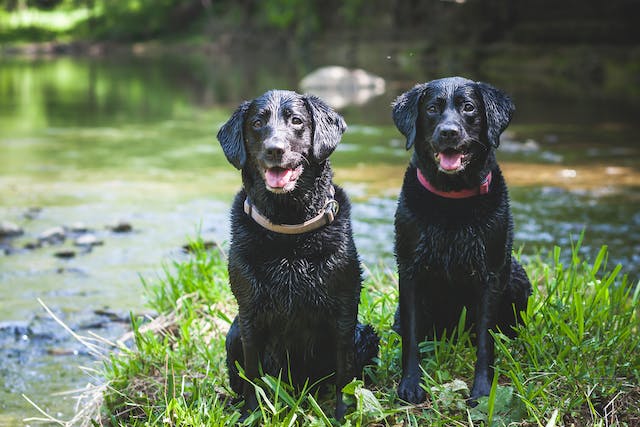
Fun facts
The earliest Labradors were St John’s water dogs, a tough cross between Newfoundlands and smaller water dogs. Fishermen bred them to retrieve fish and nets from the freezing waters of the North Atlantic. They’re still some of the toughest dogs around. Labradors are working in dangerous places and roles across the world; explosives and weapons detection, the war on illegal drugs, search and rescue.
True tails
Labradors Sadie, Treo, and Sashar saved countless lives detecting bombs and weapons with their human handlers in Afghanistan. All three received the ‘Dickin Medal’, the canine equivalent of the Victoria Cross.
Health issues: stiffness, lameness and arthritis
Compared with crossbreed dogs, Labradors are three times more likely to get arthritis, twice as likely to develop stiffness and 1.6 times as likely to become lame.

Common causes of stiffness and lameness include:
- Hip dysplasia: An unstable poorly-fitting hip joint. Anywhere between 3 and 17% of Labradors have some degree of hip dysplasia on x-rays.
- Elbow dysplasia: Abnormal growth and development of the elbow joint. Labradors are nearly 6 times more likely to get elbow dysplasia than crossbreeds. It causes limping and pain in young dogs or arthritis in older dogs.
- Cruciate ligament disease: Tearing ligaments in their knees as they twist and turn, just like footballers. It causes instability in the knee (stifle) joint. Treatment usually means an operation. But longer term arthritis is inevitable.
What to do if your dog is limping:
Rest your dog completely for 24 hours if they start limping. This means strict rest! No walks, tuggy games, ball chasing, jumping on the sofa, or going upstairs. Call a vet if strict rest does not improve things after 24 hours.
How to minimise the risk of joint problems:
Fewer Labradors get hip and elbow dysplasia nowadays thanks to the BVA hip dysplasia scheme and elbow screening programme.
- When buying a puppy, ensure the breeder has provided low hip and elbow scores for both parents.
- Feed your puppy a balanced, healthy diet appropriate for their age and lifestyle
- Keep your dog at a healthy weight and from the get-go. Learn how to check their body condition score – keeping weight off is easier than losing it.
- Limit your Labrador puppy’s exercise to two to three 15-minute walks on a lead until they’re six months old. Then, gradually increase exercise until they’re 11 months old. No ball launchers or mountain climbing until then!
Body Condition Scoring (BCS) in dogs
Body Condition Score (BCS) is a scale that gives a practical evaluation of the fat coverage of your dogs body. By checking how easy or not it is to feel certain bony areas of the body, a score is then produced. There are several scales, from 1 to 5 or 1 to 9. The ideal body condition lies in the middle, so either 3/5 or 5/9.
The body areas normally checked for fat coverage are:
1. ribs and spine
2. hips and shoulders
3. waist
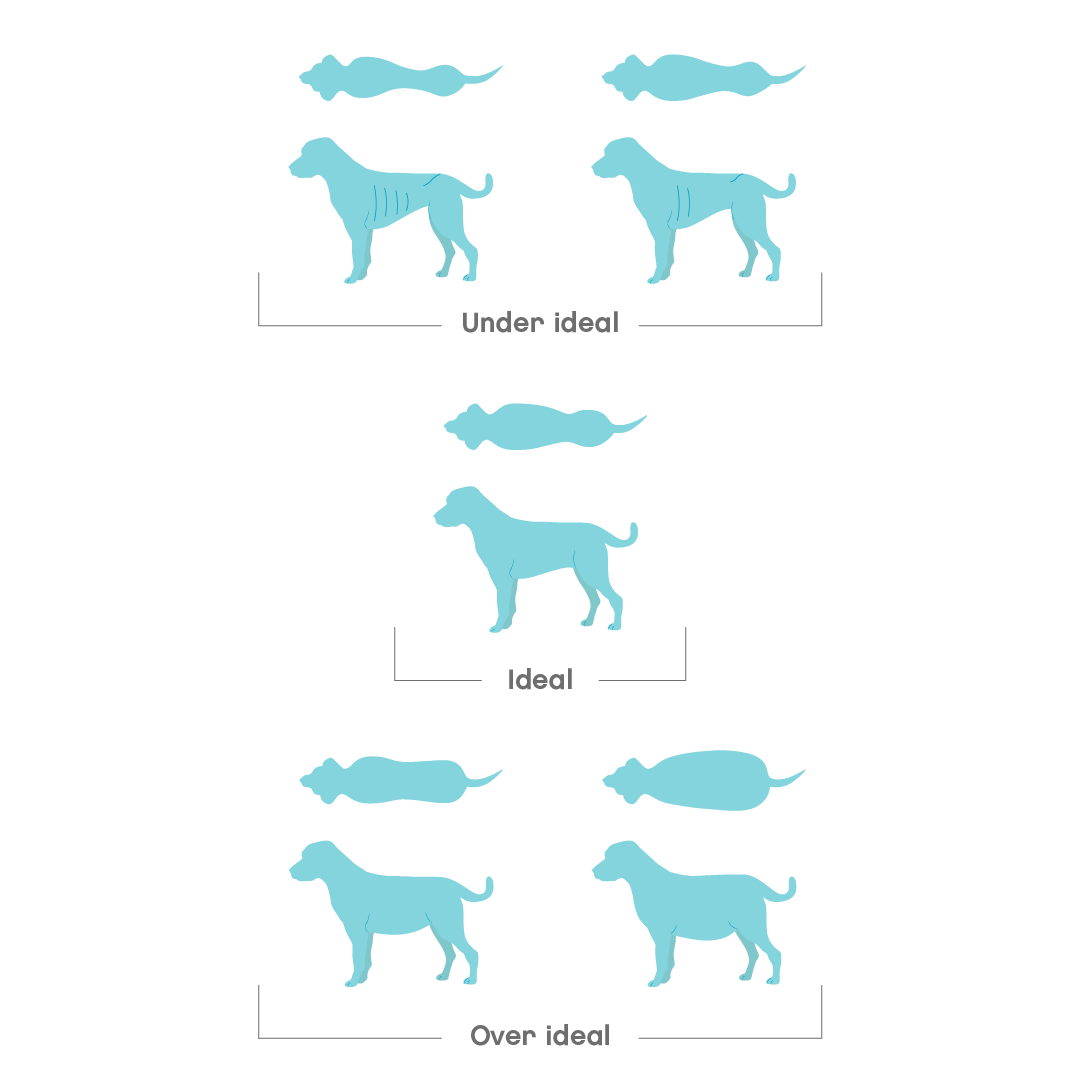
Here are a few tips on how to do it.
With your pet in a standing position:
- Place your hands on the rib cage and gently feel for each rib, without pressing too hard
- Feel the waist and look from the top and the side (if you have a very furry breed, it may be harder to assess)
- Feel the spine, which runs down the middle of the back
- Feel the top of the hips and shoulders
Part 2: Land and sea creatures!
Fun facts
Labradors have 2 layers to their coat. An outer coat of bristly short, straight hair to repel water. It can feel slightly oily to touch. And a soft undercoat for insulation.
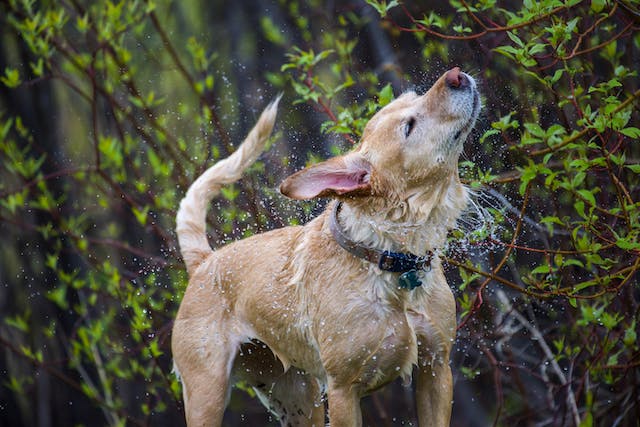
On the plus side, this makes them ideally suited to cold and wet climates and thoroughly at home in freezing cold water. And another cool fact: Labradors have webbed feet! So they’re brilliant swimmers.
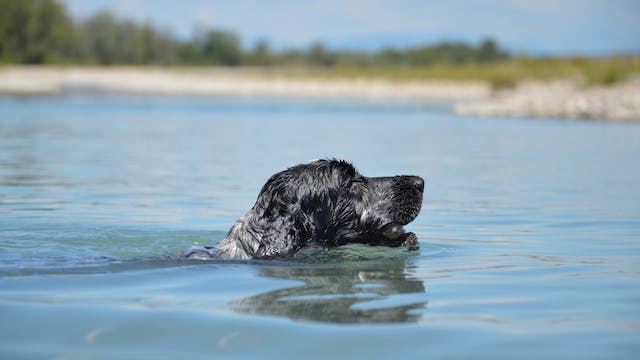
On the downside – they shed a lot. A twice-yearly moult for winter and summer coat change and daily shedding in between. It’s hard to believe one dog can leave so much hair on the carpet and not be bald.
True tails
Those canny Canadian settlers bred the perfect ‘fisherman’s friend’. But Labradors are also on duty at several beaches across the UK. Ready to rescue human bathers in trouble. And giving David Hasselhoff a run for his money!
Health issues – skin and ear conditions:
- Atopic dermatitis: Around 10% of Labradors suffer from allergic skin disease. Chocolate Labradors are most at risk.
- Hot spots: The combination of a thick coat and allergies means Labradors are prone to painful hot spots.
- Otitis externa: Inflammation and infection flourish in a Labrador’s warm, airless ear canals. Especially if they swim a lot.
What to do if your dog shows signs of irritated skin or ears
Always speak to a vet for advice. The sooner the problem can be identified and treated, the more effective treatment is likely to be.
How to minimise the risk of skin disease
- Feed a high-quality diet, suitable for age and lifestyle.
- Keep up-to-date with parasite preventive treatment.
- Clean your dog’s ears regularly. Especially if they love swimming
- Don’t bath your dog routinely – only if it’s essential for their health or preserving your sense of smell! The natural oils in their coat keep it healthy and waterproof. Overbathing can strip these and expose the skin to irritants.
Part 3: Labrador superpowers
Labradors have 2 ‘superpowers’ – an amazing sense of smell and insatiable appetite!
Fun facts:
Labrador’s sense of smell is 10000 times more sensitive than ours. They have 300 million smell receptors compared to our 6 million and can smell objects or people up to 20 km away. No wonder they make such great sniffer dogs! They can even sniff out certain illnesses and cancers in people.
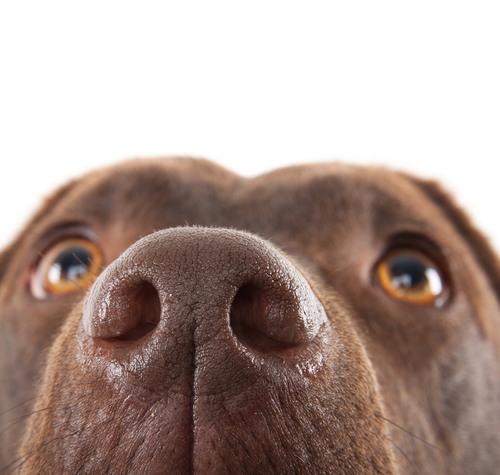
However, the Labrador sense of smell is closely matched by their insatiable appetites. Combining the two, you get a dog who’s always on the lookout for food. In fact, 23% of Labradors have a genetic (inherited) problem that causes them to overeat. The ‘fullness’ gene doesn’t work properly. They’ll eat much more than they need. And often much more than is good for them!
True tails
Twin Labradors, Lucky and Flo, were trained to sniff out counterfeit goods. They were so effective that criminal gangs put a price on their heads!!
Health issues – obesity and gastrointestinal problems
Obesity
Around 60% of Labradors are overweight or obese. Obesity is a disease, a serious illness. Fat releases harmful chemical signals into the bloodstream. This causes damage and inflammation in other tissues and organs, including their joints, kidneys, heart and pancreas.
Gastrointestinal problems
Labradors are bin-raiding, table-clearing, chew-anything dogs. Eating things they shouldn’t includes things that may be loosely called ‘edible’, like human food, entire sacs of pet food and cooked bones. Or completely inedible and indigestible, such as toys, packaging, stones, socks, sticks, corn cobs.

Risks include:
What to do if your dog is overweight or obese
Obesity is a severe and long-term health condition. However, we can manage its symptoms.
Speak with an experienced Joii vet or vet nurse for guidance and support. Specialised prescription diets and ongoing care will help you to keep your dog’s body condition healthy.
What to do if your dog has an upset tummy
- A few days of small bland meals will settle most upset tummies
- Talk to a vet as soon as possible if vomiting persists or worsens, especially if it contains blood
- Call a vet immediately if your dog eats something that could get stuck and cause a blockage or is in pain (restless, whining, lying in funny positions, tummy hard to touch)
How to prevent obesity
- Feed a healthy balanced diet. No more than 10% of calories from treats!
- Measure out food and check your dog’s body condition score regularly.
- Don’t give human food to dogs, especially fatty and sugary foods like biscuits or ice cream. Resist those puppy dog eyes!

How to prevent dietary indiscretion
Reduce the risk of your ever-hungry or over-playful fur-ball eating something they shouldn’t:
- Keep human foods, poisons and household chemicals out of sight, smell and reach of pets
- Supervise play with new toys and replace broken or worn ones promptly
Part 4: Ultimate all-terrain retrievers
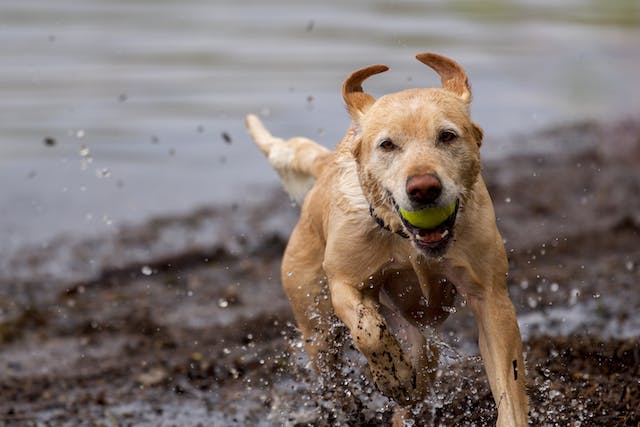
Fun facts
Labradors give it their all. Whether it’s pursuing a tennis ball or rescuing the survivors of natural disasters and human atrocities.
True tails
Jake, the black Labrador, was found on the streets as a puppy, with a broken leg and dislocated hip. Despite being abandoned by humans early on, he went on to become an elite U.S. Government Search and Rescue Dog. He spent the rest of his short life finding and rescuing the human survivors of natural disasters and man-made tragedies, including 9/11 and Hurricane Katrina.
Health concerns: Trauma, accidents and injuries:
Labradors are naturally lively, inquisitive, and playful dogs. But their enthusiasm can lead to frequent and often painful injuries.
- Cut pads and lacerations: usually from broken bottles in rivers and on paths.
- Broken bones or damaged joints.
What to do if your Labrador is injured
- Call a vet for advice.
- Call your nearest vet if your dog is in pain, unable to take weight on a leg or if a joint looks misshapen.
- First Aid: Clean wounds under running water to remove any surface glass shards or contamination. Apply pressure with a clean cotton pad or cloth to stop bleeding.
How to reduce the risk of injuries
- Avoid walking in areas where litter and broken glass are likely, especially in the dark.
- Be careful when throwing a ball, especially with ball launchers
- Don’t throw sticks for dogs. Stick and splinter injuries are very common, especially in their mouths or throats.
Part 5: Labradors and lumps
Labrador Retrievers can be trained to detect certain types of human cancer. But the breed is also prone to developing lumps and bumps.
- Lipomas or fatty lumps are common in dogs. 20% of confirmed cases are in Labradors. Lipomas are harmless unless they get so big they interfere with movement.
- Cancer: Labradors have a slightly higher risk for certain types of cancer, such as lymphomas, mast cell tumours, mammary tumours, and haemangiosarcomas.

What to do if you find a lump on your dog
- Play it safe. Call a vet for advice if you find a lump on your Labrador.
- The good news is that most cancers are treatable, especially if caught early.
- Losing weight can reduce the size and risk of lipomas on Labradors!
Part 6: Unsurpassed assistance dogs
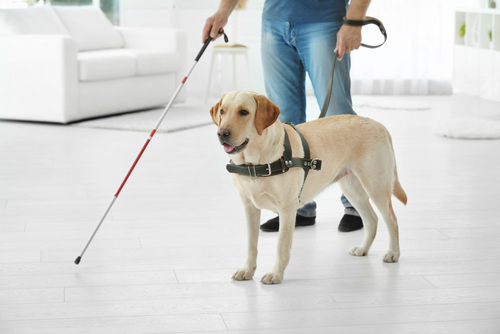
Fun Facts
- Most dogs have 20/75 vision. This means they must be 20 feet from an object to see it as clearly as a human would standing 75 feet away. But Labradors have exceptionally good sight- closer to 20/20 human vision.
- 62% of Guide Dogs in training across the world in 2022 were Labradors.

True Tails
Guide dogs, Rochelle and Salty were heroes of 9/11. When planes were crashed into the World Trade Centre in New York, they led their owners down 70 floors (1,463) steps out of a collapsing tower to safety. Loyal Salty wouldn’t leave her owner when he tried to free her so she could escape. And as soon as Rochelle got home, she just started playing with her retired guide dog pal. As if nothing ‘out-of-the-ordinary’ had happened that day!
Health concerns
As a purebred dog, Labradors have a higher risk of inherited eye conditions:
- Progressive retinal atrophy (PRA): The first signs may be your dog bumping into things at night. It eventually leads to complete blindness. Genetic screening and yearly eye checks for breeding Labradors mean fewer get PRA now.
- Entropion: Usually shows up while your Lab is still a puppy. One or both of their lower eyelids roll in towards the eye. The eyelashes rub on the cornea, causing pain and irritation.
- Cataracts: The lens inside the eye becomes opaque instead of being see-through. The affected eye(s) will look cloudy or have a bluish-grey appearance. The result is gradual blindness.
What to do
Always call a vet if you’re worried about your dog’s eyes and eyesight.
Part 7: Super-intelligent canine superheroes.
But are you right for them?
Fun Fact
They’re the 7th most intelligent dog breed out of 190 recognised in the USA.
Ok, collies may be smarter. But for calm trainability, devotion and gorgeous floppy ears, Labradors have the edge!
(Amazing but) True tails
No account of Labradors would be complete without mentioning Endal, winner of the Dickin Medal and the UK’s most famous assistance dog. Endal supported disabled ex-serviceman Allen Parton.
Endal could:
- Load and unload a washing machine.
- Operate buttons and switches.
- Use chip and PIN ATM’s. Then return the card to his owner’s wallet.
- Fetch items off supermarket shelves and get the newspaper.
- Put his unconscious owner in the recovery position after he was knocked from his wheelchair by a car. Without ever being trained to do this!
Playful, devoted, active, inquisitive and smart.
Health Concerns
Labradors need exercise. It’s in their makeup to work hard and play hard. As pet owners and pet parents, it’s our duty to provide them with all they need to stay happy and healthy.
- At least 2 hours of high quality exercise per day: running, playing with pals, fetching.
- A couple of short ambles round the block each day is not enough.
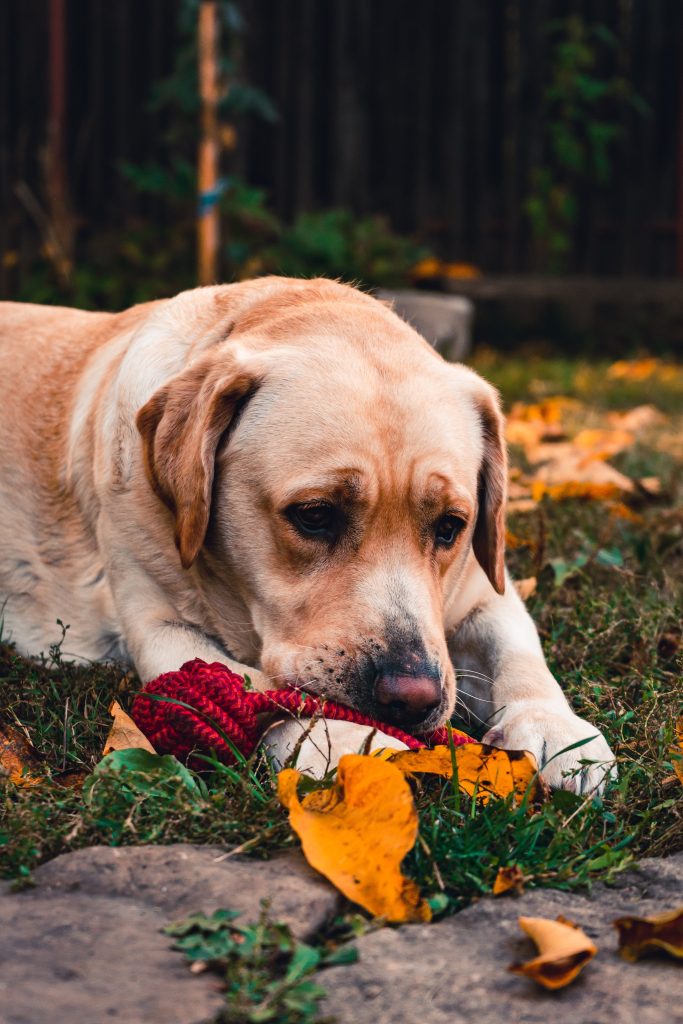
Health concerns
Labradors who don’t get the right amount of play or exercise risk:
- Becoming bored and lethargic
- Gaining weight and getting joint problems
- Becoming highly strung and barking
- Chewing things and becoming destructive
What to do for a healthy and happy dog
We can be best friends to man’s bestest best friend by giving them:
- Lots of exercise
- A healthy diet
- Mental stimulation
- Our company
- And our endless, unconditional adoration

How can anyone resist?

